2200 BC: People on an island off the coast of northern Scotland selected beautiful, monolithic stones filled with quartz and hornblende (a dark, crystalline mineral) and moved these massive, multi-ton stones for several miles across the land. They erected the Callanish circle on a hilltop with a view of Loch Roag and the mountains to the south. And they probably aligned these stones with lunar cycles.
2012 AD: I spent three days at that ancient stone circle, Callanish (or Calanais in Gaelic). Why did I fly to the remote Isle of Lewis on the outermost, windswept Hebrides with no other agenda than to look at a bunch of old rocks? That’s hard to explain to anyone who’s never been captivated by these mystic sites, built during prehistoric times in what’s now Britain, Ireland, and France.
My obsession with standing stones could be because the purpose of these stones is a riddle that will never be solved. Archaeologists, astronomers, and ethnologists can hypothesize, but we’ll never know the complete “truth.” Stone circles are at the intersection of myth and reality, so in an age when we seek scientific answers to every conundrum, their mysteries intrigue me.
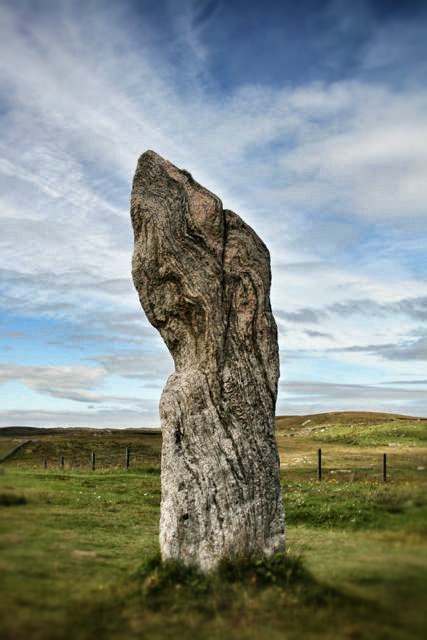
My favorite stone at Callanish looks a little fin-like and has a swirling grain. © Laurel Kallenbach
Or maybe my love of stones has to do with their strength and durability. A 4,000-year old-circle embodies permanence. My own life span will come and go, but these stone structures will last forever—or at least a whole lot longer than me.
Beauty in Rock
Regardless of esoteric pondering, Callanish is simply beautiful. Its stones are delicate, interestingly shaped, crisscrossed with grain, and crusted with crystals and lichens. And it’s a joy to watch the light change on them.
Every evening after dinner—which I ate at the Calanais Visitor Centre because there are no other restaurants nearby—I wandered among the stones as the golden sunlight peeped out from behind the clouds and made the stones glow.
Early evening happens to be when the crowds who come on tour buses have gone, and a devotee like myself can spend some quiet time in the circle.
My first evening at Callanish, when I was massively jetlagged after that day’s journey from Colorado to Scotland, I had a half-hour to say “hello” to the stones with no one else there. In private, it’s wonderful to hug a stone, to run your hand over its textured lumps and crevices. Some people will do this in public, but it’s nicer to have some privacy. I’m shy about such things; I think the proud stones might likewise be a bit sheepish about public displays of affection.
The following two evenings, the weather was clearer, and the serious photographers with their tripods and long lenses appeared as the sun sank on the horizon. The photographers are a quiet lot, mentally calculating F-stops and ISO settings and deciding where and when the sun would turn the sky peach, then pink, then hopefully salmon and crimson. I was busy snapping shots too, although at sometime every evening I would sink into the grass with my back against a stone and bathe in the warm rays as day faded.
Nightfall comes again, as it has for four millennia in the memory of stones.
—Laurel Kallenbach, freelance writer and editor
Next blog post: An archaeo-astronomer reveals some secrets of the Callanish stones.
Seeing the Stones
- There is no admission fee to the Callanish Stone Circle, and you can visit anytime, day or night.
- The Calanais Visitor Centre is open Monday through Saturday from 10 a.m. to 9 p.m. April through September. During winter months (October through March) the Visitor Centre is open Wednesday through Saturday). It contains a very nice coffee shop/restaurant, gift shop, and toilet facilities.
- Unlike at Stonehenge, visitors can walk through the circle and touch the stones. Although there are no signs forbidding it, I suggest that people not climb on the stones in order to protect this beautiful site—and to avoid having to rope it off as it became necessary to do at Stonehenge.
- I stayed at a nearby farmhouse B&B, the wonderful Leumadair Guest House. I could see the main Callanish circle from my bedroom window, and the circle was just a scenic, 15-minute walk away.
For more info, click on Visit Scotland or Isle of Lewis.
Related posts:
- 5 Reasons “Outlander” Fans Will Love Scotland’s Isle of Lewis
- Sustainable Farm B&B with a Callanish View
- Uncovering Callanish’s Archaeological Secrets
- Full Circle: Standing Stones in Ireland
- An Irish Dolmen and a Magical Dog
- Finding Inspiration on Scotland’s Isle of Cumbrae
- A Birthday among the Ancient Rocks of Stonehenge
- Exploring Myth and Prehistory at England’s Rollright Stones

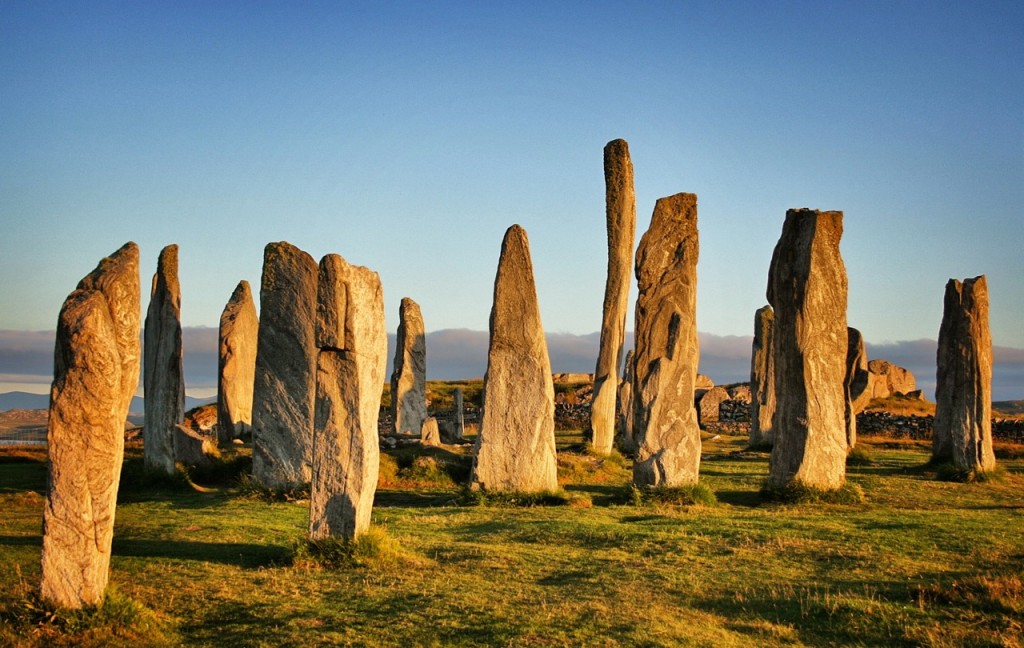
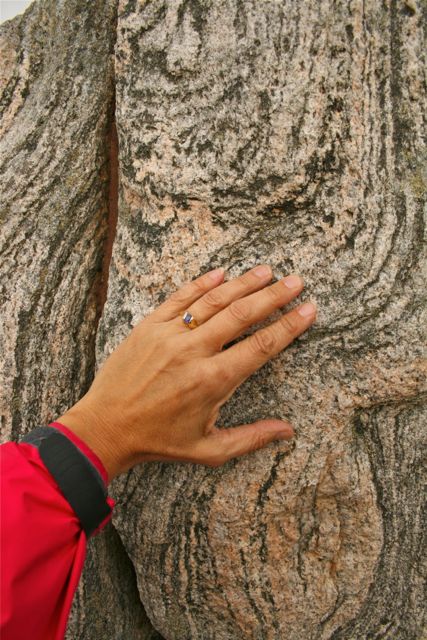
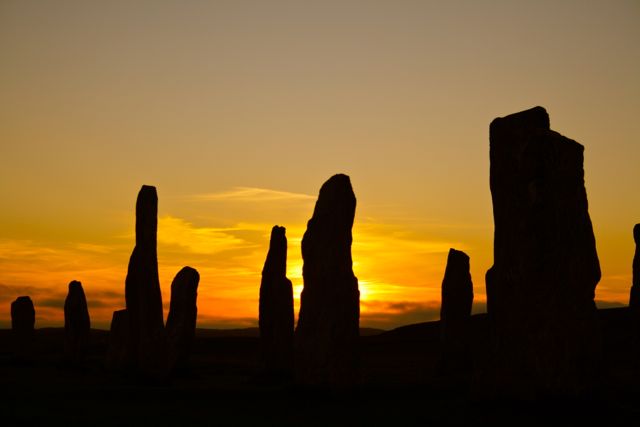
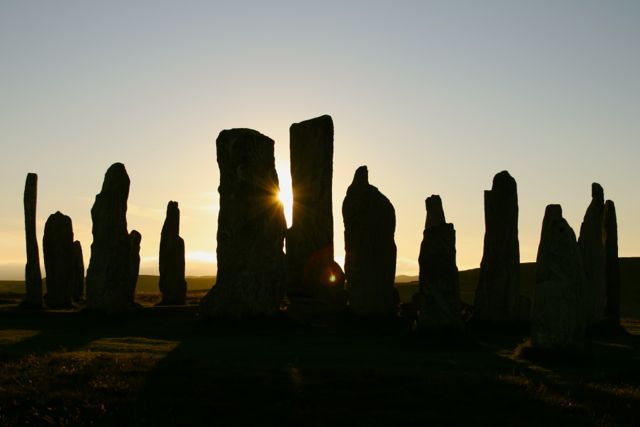
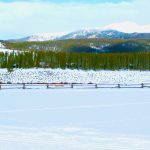
Such a fascinating article, and so beautifully written! Plus beautiful photographs.This makes me want to go to Scotland and hug a stone (in private). Really looking forward to the next installment of your trip!
Oh how I miss the magic of the British Isles! Thanks for bringing a little back for me!
You’re welcome! There are so many places to experience in Britain–both prehistoric and historic. Just heard that archaeologists think they’ve discovered the bones of Richard III. I just saw Shakespeare’s play about that king this summer!
I love stone circles, too. Stones and trees of the British Isles, in particular, strike something deep within me. I just read a piece that says scholars now suspect that Stonehenge was actually a monument to peace, as warring factions came to some conclusion and rest regarding the division of turf. People seeking spiritual direction at the stones may find that disappointing, but I think it’s a fantastic dimension to the way in which we “know” the stones. Imagination is a big part of sacrality and of sacred sites. Our perceptions connect us to places, be it a corner shrine on the highway, the stones of Callanish, or a cathedral. Stones work for me!
A few years ago a team of archaeologists excavated at Stonehenge in hopes of confirming their hypothesis that Stonehenge was a healing center. And archer-astronomer Margaret Curtis calls the Callanish stones “a community center.”
Beautiful Laurel. Thanks for sharing. Was this trip official, on assignment? I appreciate your writing and photos and look forward to seeing/reading more.
The Scotland portion of the trip was all my planning, but I certainly hope to write about Callanish for a magazine. Fingers crossed!
Wow! Amazing photos Laurel! Sounds like a great trip. Thanks for sharing it.
Laurel: You learned well from the word-power classes in school and the many outdoors experiences we shared as a family during camping trips. The excellent article transported me to the site.
I think we can feel some connection with those ancient peoples when we are there. Beautiful photos. Wish I was there.
“Sink into the grass with my back against a stone…” and we are there with you.
Thanks.
This made my day, Laurel, beautiful post and photos. Especially loved the part about your hugging the stones, can relate!
Yes, you’ve done your share of stone and tree hugging!! Can’t wait to read your book about your adventures on the Pacific Crest Trail!
I usually like to hug trees, but you’re making me want to go to Scotland and hug a rock!
I couldn’t agree more–there’s something magical about rocks. And in a constantly changing techno world, it’s nice to commune with something of such fortitude and permanence. Thanks for sharing.
Though I have been to many stone circles (they are an inner and sacred passion) , being with the stones at Callanish has been the deepest of my heart and soul’s dreams! Thank you Laurel, for leading the way so that the trip is more possible. I intended to go to stone circles in Ireland this next April and yes the secret desire was to make it all the way to above Scotland to the Callanish stones–now with your loving guidance I can really see making it there!! And yes sinking in the grass with one’s back against a stone would be an incredible experience–I love it after all the tour buses leave!! Will the weather in April be warm enough there, so that I could stay til or past sunset??! Thank you for your adventuring Spirit,C.
I’m sure you’ll love Callanish! I haven’t been there in spring, but the Visitor Centre opens again starting in April. Because it’s so far north, there will be quite a bit of light. Not sure about the temperature. I’d bring plenty of wool and waterproof clothes. Rain pants are nice because then you can sit on the ground even if it’s damp! Happy travels.
Magic, indeed! Thanks for sharing. I think your favorite stone looks like petrified wood with those burls…
i stood in front of Paul Caponigro’s amazing photograph of Callanish
for almost 3 hours (in Sante Fe, NM 1986). After a time I heard the original chanting of the people who built this circle. I’ll never forget the sense of deep connection with the cosmos.
hope to make it there in person.
Thank you for the lovely reminders…..
Here’s to you making the pilgrimage sometime soon!
These stone look amazing, is there magical qualities to these stones, does anyone really know. Can a person time travel through these stone. Ya know there is truth in myths and legends. I beleive in magic in the universe, and it starts with math, somethings going on, I know it. I’d like to go there someday, and to England. Linda Safley
There’s definitely a magical feeling a Callanish–as much magic as you want there to be!!
I want to return to the callanish stone country soon
Hi Laurel
I came across this blog post of yours while researching the standing stones at Callanish. I felt compelled to write having understood your fascination and affection for standing stones. I drove over 450 miles, took a 90 minute ferry to spend New Year’s Eve at the Callanish Standing Stones and how lovely it was to have seen in the New Year at midnight with four complete strangers all doing the same.
I I slept in my makeshift campervan overnight and returned pre-dawn on New Year’s Day to capture the rising sun. It was sure a magical experience and without a doubt has become the most memorable way to see in a new year.
Thank you for writing your blog and best wishes to you on your future travels.
Kind regards Melvin
p.s. you may see (hopefully if this site permits links within the text) an image of sunrise at Callanish. https://www.facebook.com/MelvinNicholsonPhotography/photos/a.517072421638633.122862.512633402082535/1785636528115543/?type=3&theater
What a glorious photo! And what a wonderful idea to ring in the new year at the Callanish Stones! If I lived in Britain, I think that’s what I’d do too!
Hello Laurel,
thank you so much for your uplifting post and those fabulous pictures of the Callanish stones.
We have been privileged to move to the Isle of Lewis a few weeks ago. It is an island that grabs hold of ones soul and never lets go again. Much like you we are caught by the spirit of “old stones”. Unexplainable at this time, as there is a veil of forgetfulness placed over our premortal existence, those places seem to whisper to our soul that there exists a connection between us and our ancestors, those who have walked this earth before us. Although unseen and unexplainable, it can be felt and we are unable to deny it. We know that we are connected to those of the past and of the future, and that we are nothing without them and they are nothing without us. We belong together like the northpole and southpole of a magnet. It is wonderful to share this knowledge with others, like you, who likewise feel and know and acknowledge.
Whenever you come back to Callenish please get in touch.
Frank and Kathy